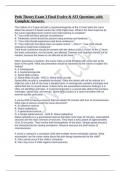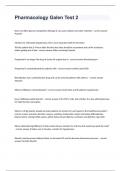Peds Theory Exam 3 Final Evolve & ATI Questions with
Complete Answers.
The mother of a 3-year-old with a myelomeningocele at the L2 level asks the nurse
about the amount of bowel control her child might have. What is the best response by
the nurse regarding bowel control once toilet training is complete?
A. "Your child will have periodic incontinence."
B. "Moderate control should be present using enemas and laxatives."
C. "Your child should experience total fecal continence."
D. "Your child will most likely have no bowel control." - ANS C. "Your child should
experience total fecal continence."
Total fecal continence should be present with the defect at the L2 level. At the L2 level,
the lower extremities, not the bowel, are affected. Enemas and laxatives should not be
needed, because the bowel is not affected at this level.
When assessing a newborn, the nurse notes a small dimpling with some hair at the
base of the spine. What documentation would be expected by the nurse to explain this
finding?
A. A meningocele
B. A myelomeningocele
C. Spina bifida cystica
D. Spina bifida occulta - ANS D. Spina bifida occulta
Spina bifida occulta is completely enclosed. Often this defect will not be noticed or it
might be only a tuft of hair near a dimpled area. A meningocele contains meninges and
spinal fluid but no neural tissue. Unless there are associated cutaneous findings, it is
often not identified until later. A myelomeningocele is a neural tube defect that contains
meninges, spinal fluid, and nerves. Spina bifida cystica is a cystic formation with an
external saclike protrusion.
A young child is having a seizure that has lasted 35 minutes with loss of consciousness.
What type of seizure would the nurse document?
A. An absence seizure
B. Status epilepticus
C. A generalized seizure
D. A simple partial seizure - ANS B. Status epilepticus
Status epilepticus is a generalized seizure that lasts more than 30 minutes. Generalized
seizures are the most common of seizures. They have a tonic phase of approximately
10 to 20 seconds. They involve both hemispheres of the brain. Simple partial seizures
are characterized by varying sensations. Absence seizures are brief losses of
consciousness.
A nurse is caring for a comatose child with multiple recent orthopedic injuries. What
assumption can the nurse make about the pain being experienced by the child?
A. Pain cannot occur if the child is comatose.
B. Pain may occur if child regains consciousness.
,C. It requires frequent and comprehensive assessment by the nurse.
D. It is best assessed by family members who are familiar with the child. - ANS C. It
requires frequent and comprehensive assessment by the nurse.
Because the child cannot communicate pain using one of the standard pain rating
scales, the nurse must be focused on physiologic and behavioral manifestations such
as restlessness and an elevated blood glucose that denote stress and often pain. The
family can provide insight into different responses, but the nurse should be monitoring
physiologic and behavioral manifestations. Pain can occur in the comatose child. The
child can be in pain while comatose.
A newborn with a myelomeningocele is scheduled for surgery within the next 48 hours.
What is the correct nursing care during the preoperative stage?
A. Place the child in the side-lying position to decrease pressure on the spinal cord.
B. Apply a heat lamp to facilitate drying and toughening of the sac.
C. Keep skin clean and dry to prevent irritation from diarrheal stools.
D. Measure head circumference and examine fontanels for signs that might indicate
developing hydrocephalus. - ANS D. Measure head circumference and examine
fontanels for signs that might indicate developing hydrocephalus.
Hydrocephalus is frequently associated with myelomeningocele. Assessment of the
fontanels and daily measurements of head circumference will aid in early detection.
Preoperatively, the child is kept in a prone position to decrease tension on the sac and
reduce risk of trauma. The sac must be kept moist, so sterile, moist, non-adherent
dressings are placed over the sac to prevent any leaks or tears from occurring. Most
newborns do not have diarrheal stools. They are still expelling meconium.
The nurse is admitting a young child to the hospital with possible bacterial meningitis.
What is the priority nursing care?
A. Initiate isolation precautions as soon as the diagnosis is confirmed.
B. Administer antibiotic therapy as soon as it is ordered.
C. Initiate isolation precautions as soon as the causative agent is identified.
D. Administer sedatives or analgesics on a preventive schedule to manage pain. - ANS
B. Administer antibiotic therapy as soon as it is ordered.
Administration of antibiotic therapy as soon as it is ordered is the priority action.
Antibiotics are begun as soon as possible to prevent death and avoid resultant
disabilities. Isolation should be instituted as soon as a diagnosis is suspected.
Antibiotics are the priority function; pain should be managed if it occurs. Isolation should
be instituted as soon as a diagnosis is suspected.
The nurse is caring for a child with the beginning ascending paralysis of Guillain-Barré
syndrome. What nursing actions should be implemented in the care of this child?
Select all that apply.
A. Use play as a means of assessing the child's neurologic abilities.
B. Assess pulse oximetry measurements daily.
C. Listen to lung sounds several times daily.
,D. Reposition the child every 4 hours.
E. Allow the child to eat as long as the cranial nerves are intact.
F. Measure each urine, watching for decreasing amounts. - ANS A, C, E, F
Play can be used as a means of assessing the child's neurologic abilities by having the
child push with his feet and hands, hold an object, do puzzles, and so forth to determine
his gross and fine motor abilities. Lung sounds should be checked several times daily,
as well as chest excursion, depth of respirations, and energy expenditure needed to
breathe. The child may eat as long as the cranial nerves are intact. When aspiration is a
potential problem, then enteral feedings will be instituted until the gag reflex returns.
Urine output must be watched to detect any inability to void. Pulse oximetry
measurements should be done either continuously or every few hours. The child should
be repositioned every 2 hours.
A nurse is caring for a toddler after surgery for a brain tumor. During an assessment the
nurse notes that the toddler is becoming irritable and that the pupils are unequal and
sluggish. What is the most appropriate nursing action?
A. Notify the physician immediately.
B. Assess for level of consciousness.
C. Administer a low dose of pain medication.
D. Continue monitoring for signs of increased intracranial pressure (ICP). - ANS A.
Notify the physician immediately.
The worsening of symptoms, irritability and unequal pupils, may indicate that the ICP is
increasing. The physician should be notified immediately. Assessing for level of
consciousness should be done as part of the overall assessment. Pain medication
should not be given. Consultation with the physician should occur first. The nurse is
noting signs of potentially increased ICP.
A school-age child begins to have a tonic-clonic seizure in bed as the nurse walks into
her room. What actions should the nurse take?
Select all that apply.
A. Gently place an oral airway in the child's mouth.
B. Turn the child on her side once the seizure subsides.
C. Hold the child's head so it doesn't hit the headboard.
D. Get additional pillows to pad the siderails.
E. Note how long the seizure lasts.
F. Note whether any incontinence occurs during or after the seizure. - ANS B, E, F
The child should be placed on her side, in recovery position, after the seizure ends. The
nurse should note how long the seizure lasts, what body parts are involved, any
vocalizations made during the seizure, presence or absence of incontinence, and level
of consciousness after the seizure ends. Presence or absence of incontinence should
be noted, and if it occurs when, whether during the seizure or afterward. Nothing should
, be placed in a patient's mouth during a seizure. The child should not be restrained
during the seizure. The nurse should stay with the child during a seizure.
A woman 6 weeks pregnant tells the nurse that she is worried the baby might have
spina bifida because of a family history. What response would be most helpful to the
patient?
A. "There is no definite genetic basis for the defect."
B. "Low levels of folic acid at the time of conception have been strongly linked to neural
tube defects."
C. "Chromosomal studies done on amniotic fluid can diagnose the defect prenatally."
D. "The concentration of alpha-fetoprotein in amniotic fluid can indicate the presence of
the defect prenatally." - ANS D. "The concentration of alpha-fetoprotein in amniotic fluid
can indicate the presence of the defect prenatally."
Fetal ultrasonography and elevated concentrations of alpha-fetoprotein in amniotic fluid
may indicate the presence of neural tube defects. The origin of neural tube defects has
several factors, including deficient maternal levels of folic acid at the time of conception
and a possible, but unproven, genetic predisposition. This is true, but the woman is
already 6 weeks pregnant and the neural tube is developing. The focus needs to be on
determining if the problem exists. There is one chromosomal study for spina bifida at
this time.
After being told that her premature, 8-month-old most likely has cerebral palsy, the
distraught mother asks the nurse after the physician left the room about what could
have caused this. Which explanation regarding common causes of cerebral palsy
should be shared by the nurse?
A. A sex-linked recessive inheritance pattern and neonatal disease
B. Birth-related brain anoxia and post-maturity status
C. Prematurity and faulty brain development
D. Faulty mother-infant bonding and neonatal meningitis - ANS C. Prematurity and
faulty brain development
Cerebral palsy results from faulty development (brain anomalies) during the prenatal
period or from damage during the perinatal period, including brain anoxia and cerebral
trauma during delivery and prematurity. Mother-infant bonding has nothing to do with
the development of cerebral palsy, and meningitis in the newborn is very rare. Cerebral
palsy is not genetic, and neonatal disease is not a common cause. Birth-related brain
anoxia at times has caused cerebral palsy but prematurity, not post-maturity, is the
problem.
The parents of a 5-month-old with infant botulism ask how their infant got sick. What is
the best response by the nurse?
A. "Infants who have crawled around a dirty kitchen floor can pick up the toxin from food
scraps."
B. "The use of honey to sweetened the infant's formula can cause botulism."
C. "Feeding commercial infant cereals too early can cause the problem."
D. "Improperly sterilized bottles can contain the toxin causing infant botulism." - ANS B.
"The use of honey to sweetened the infant's formula can cause botulism."





